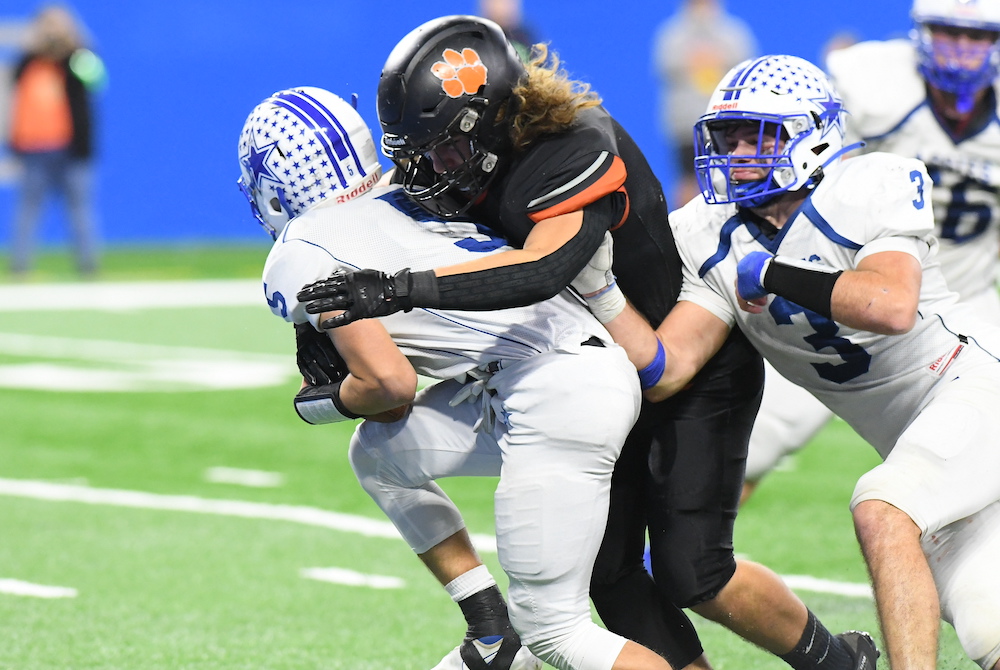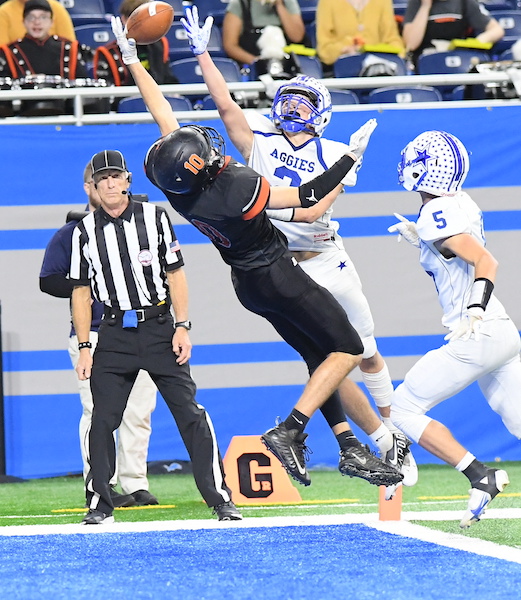
Inside Selection Sunday: Mapped Out
October 19, 2012
By Geoff Kimmerly
Second Half editor
NOTE: This originally was published Oct. 24, 2011, after selection of last season's playoff field. It's an explanation of how the MHSAA creates the playoff pairings for its football tournaments, a delicate task we will undertake again Sunday.
Sitting on the other side of this process for a number of years, I can admit to occasionally scratching my cynical head over some of the matchups that have come out of Selection Sunday.
How could teams so far from each other play in the same district? Why would two schools in the same town play in different regionals? Are they picking out of a hat at 1661 Ramblewood Drive?
Now, I have answers.
Sunday morning, we filed into headquarters for what might be the most important non-game day on the MHSAA calendar. “We” were made up of half of the MHSAA staff, plus a representative from the Michigan High School Football Coaches Association.
Here’s some of what I learned from being a part of the process:
- First, a brief history lesson. In early years (or until the middle of the last decade), lines were drawn by hand. Dots representing qualifying schools were pasted on maps, one map for each division, and those maps were then covered by plastic sheets. Districts and regionals literally were drawn with dry-erase markers. No longer. Using a variety of spreadsheets and mapping software, we’ve gone digital. Staff is split into two teams, each considering four divisions (and the 8-player map) before we reconvene and look at all nine divisions together.
- We are presented digital maps of the state covered in dots. That’s about it. The rule of the day, simply, is “geography rules.” Which teams are represented by the dots is not considered, much less discussed, until lines are drawn. While considering my group’s first map, I began to bring up teams – and immediately was shot down (with good reason). Teams, matchups, rivalries, previous playoff pairings, etc. DO NOT come into play. We draw boxes in what we figure are the most logical ways of making districts and regions work.
- Travel distance and ease DO come into play. This especially is true when considering which districts will include teams from the Upper Peninsula. An example: Marquette is closer to the schools we placed in its district – Fenton, Bay City Western and Okemos – than some other options because those schools are closer to I-75. Schools further north on the map but farther from a main highway would’ve created longer trips.
- Sometimes, maps get ugly. And sometimes, it was a matter of choosing the least ugly situation. Of course, a Division 4 District of Lansing Sexton, Dearborn Heights Robichaud, Battle Creek Pennfield and Vicksburg isn’t ideal. But with no other Division 4 schools within 35 miles of Lansing, we were put in a tough spot. Add in that there were 13 teams in the Detroit area, leaving one as the odd team out of three districts based there. Something had to give, and drawing things up as we did caused the fewest messes.
- Considering how to set up the entire state is different than figuring out what teams make the most sense for just one school or area. And shifting just one dot on a map can change things for all 32.
- Back to “geography rules.” The Division 8 district including Saugatuck, Muskegon Catholic, Mendon and St. Joseph Lake Michigan Catholic might be the most competitive, on paper, in the state. Saugatuck is the reigning MHSAA runner-up in the division, and Muskegon Catholic and Mendon were ranked Nos. 1 and 2, respectively, in the most recent Association Press poll. Seeing that after we’d drawn the line caused a collective “ouch.” But again, the line was drawn based on dots on a map.
I thought back on some of the matchups I’d questioned in the past, and came back to what I’d ask people now: How would you do things differently?
I imagine there would be some creative answers, but I also would guess we considered those scenarios too.
And remember, determining the playoff schedule is just one step in many. Eight state champions must survive it, regardless of which opponents they face along the way.

Hudson Rides Dominating Defense to Lock Down Division 8 Title
By
Paul Costanzo
Special for MHSAA.com
November 26, 2021
DETROIT – For a team not used to giving up points – or yards, for that matter – it would have been easy Friday for Hudson to make some big changes at halftime to slow down a Beal City offense that had found success through the passing game.
But the Tigers – who entered the MHSAA Division 8 Final having allowed 107.7 yards and less than a touchdown per game through the Semifinals – didn’t stray from the gameplan.
“Honestly, (the adjustment was) just keep playing,” Hudson coach Dan Rogers said. “They did a great job, their line, we couldn’t get pressure on the quarterback. He could get out on the edge and we struggled getting to him. That made us cover a lot longer than we want to, so we were trying to get to the quarterback a little bit more, keep the receivers in front of us and make plays on the football.”
It worked, as Hudson smothered Beal City in the second half, allowing just 17 yards over the final 24 minutes of its 14-7 victory at Ford Field to claim its second Finals title.
“I can’t even describe it yet; it hasn’t really hit me yet,” said Hudson senior running back and safety Bronson Marry, who had a crucial late-game interception. “I’m just waiting to walk out of the locker room and find our families. It’s going to (hit like) a brick wall.”
While Hudson (14-0) never led by more than one score, Beal City never threatened to overcome it, spending the entirety of the second half offensively on its own side of the field. The Aggies’ five second-half possessions went for 4, -6, 13, 1 and 5 yards, and totaled 5 minutes and 29 seconds.
A fumble, an interception and downs ended the last three drives, with Nick Kopin breaking up the final Beal City pass attempt with 1:51 to play, sealing the game. It was a fitting end to Kopin’s big day, as he also had forced a fumble earlier in the fourth quarter and rushed for 131 yards and both of Hudson’s touchdowns.
“It’s amazing,” Kopin said. “Obviously, I’m going to credit all my runs to our offensive line and our play-calling by coach (Jeremy) Beal. It set up really good cutbacks, and they were blocking real well. Defensively, credit to (Coach Rogers), he’s very strict on us reading our keys and doing our jobs. I think all of us, including myself, just did that, and the game turned out in our favor.”
 Kopin’s second score, a 2-yard run, came with 6:58 to play and put the Tigers up 14-7. The two-point pass was no good, however, keeping Beal City within a touchdown. The Aggies received a further boost with the return of quarterback Hunter Miles, who had been injured midway through the third quarter, but Hudson’s defense didn’t allow for a storybook comeback.
Kopin’s second score, a 2-yard run, came with 6:58 to play and put the Tigers up 14-7. The two-point pass was no good, however, keeping Beal City within a touchdown. The Aggies received a further boost with the return of quarterback Hunter Miles, who had been injured midway through the third quarter, but Hudson’s defense didn’t allow for a storybook comeback.
“Hunter Miles is Hunter Miles; he’s a warrior,” Beal City coach Brad Gross said. “That’s Hunter Miles. Ankle, ribs, everything else (was hurt). We have a lot of guys dinged up. Cade Block’s had a (injured) shoulder that he’s been playing with for three weeks. Wade Wilson has a broken hand that he played the whole game with. We’re just banged up. We have a bunch of warriors. That’s why we’re here.”
Miles had more success in the first half, mostly on the strength of a pair of big pass plays to Carter Fussman. The first was a 53-yard touchdown pass late in the first quarter. Miles rolled to his right before finding Fussman open near the 10-yard line.
The second was a 56-yard throw and catch on the penultimate play of the first half, which came immediately after Hudson had taken an 8-7 lead on a 2-yard run from Kopin and a two-point conversion pass from Anthony Arredondo to Ambrose Horwath. The big pass play ended with Fussman being hauled down by Horwath at the Hudson 7-yard line with four seconds left in the half.
That tackle wound up being enormous, as an incomplete pass on the next play ended the half with Hudson still in the lead.
“It probably made the conversation at halftime better,” Rogers said. “It was a huge tackle. That’s what we talk about: You just have to keep playing. They’re going to make plays, things are going to happen, and it would have been just as easy to hang your head and he runs into the end zone. Our kids don’t do that, and Ambrose, he made a play, and that’s what we had to have.”
Hudson’s offense had success on the ground, rushing for 282 yards, but strong red zone defense from the Aggies kept them in the game. All five of Hudson’s second half drives – excluding the final one, which consisted of three kneel downs – ended at least within the Beal City 35, but just one led to a score.
“You have to give credit to Beal City, too,” Rogers said. “When we got down there, they stiffened up defensively and took all the inside runs away. Unfortunately, we weren’t able to score and it kept the game close.”
Payton Rogers added 62 yards on the ground for Hudson, while Horwath hauled in the lone completed pass for the Tigers, a 17-yard catch from Easten Strodtman that converted a 3rd-and-long on the Tigers’ fourth-quarter touchdown drive. Kopin led the Hudson defense with six tackles, while Strodtman and Ethan Harris each recorded a sack.
Fussman led the Beal City (12-2) offense with two catches for 109 yards, while Miles finished with 128 yards through the air – all in the first half. Josh Wilson recorded 13 tackles to lead the Beal City defense, while Miles had eight.
PHOTOS (Top) Hudson’s Easten Strodtman brings down Beal City quarterback Jack Fussman during Friday’s Division 8 Final. (Middle) The Tigers’ Ambrose Horwath (10) tries to get a hand on the ball with the Aggies’ Carter Fussman (2) and Jack Fussman defending. (Photos by Hockey Weekly Action Photos.)

